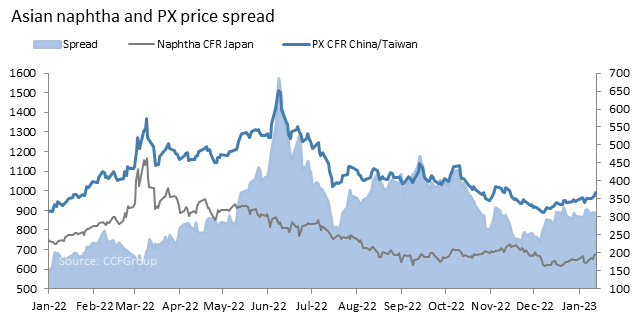PX bolstered by slow production growth and rapid demand increase
Crude oil has been consolidating in the lack of advancing momentum since Jan. However, PX price and its spread to naphtha strengthens. PXN spread hovers at around $300/mt, high point since mid-Nov 2022.

1. Production growth from new plants is slower than expected.
| Company | PX capacity (kt/yr) | Startup |
| Dongying Weilian Phase II | 1000 | End-Nov 2022 |
| Shenghong 1# | 2000 | Mid-Nov 2022 |
| Shenghong 2# | 2000 | Jan 8, 2023 |
Though there have been new PX plants with combined capacity of 5 million mt/yr started production since end-Nov 2022, the contribution to PX production growth was limited, as Dongying Weilian shut Phase I PX plant for maintenance after the startup of Phase II, Shenghong’s first PX line kept operating rate at 60-70%, and its second line has only been started for 1 week. In addition, ZPC and CNPC Urumqi reduced plant operating rates in Dec. China domestic PX plant average operating rate was lower than 70% in Dec 2022, with production increasing by only 100kt from the month earlier. In the first half of Jan, production growth is still limited, however, demand for PX recovers rapidly in Jan.
2. China domestic PTA plant operating rate rises rapidly.
PTA processing spread has recovered fast to above 500yuan/mt since late Dec. Domestic plant operations were incentivized with operating rate up to 69% as of Jan 12. In the future, Yisheng is also poised to restart its PTA plant. Therefore, demand for PX has increased obviously.

However, negotiation for feedstock PX in 2023 made slow progress, impacting the feedstock reserves at PTA plants. After the continuous inventory reduction in 2022, PTA plants are under strains from low feedstock.
With domestic PX production lower than expected, and imported contract goods negotiation making slow progress, CCFGroup estimates that China PX inventory could drop again in Jan 2023. The imports are estimated at 500-600kt in Jan. Therefore, it is heard that some PTA producers are active in buying spot PX, which drives up PX prices.
In the future, China PX supply is expected to increase gradually.
Shenghong Refining would ramp up production gradually. Dongying Weilian Phase I is expected to restart after its PTA plant is started. PetroChina Guangdong is poised to start its new plant during this weekend (Jan 14-15), to get PX product in the middle of the next week and may achieve stable production in Feb. In addition, some plants, with reduced operating rates, are raising the run rates gradually. With Shenghong’s second PX line and PetroChina Guangdong’s new plant excluded, China PX plant operating rate is expected to rebound to 73% in Jan 2023.
However, it is noteworthy that PX market is still impacted by refined oil market. PX-MX price spread has widened obviously since Dec, but with crude oil rising, gasoline price has hiked apparently. China gasoline price advanced heavily, with COVID restricted lifted and the nearing of Spring Festival. The economics of using MX as gasoline blending component is currently better than using MX to produce PX, based on yuan prices, while economic of PX-MX on USD basis is better than MX in gasoline blending.
Though some plants could purchase MX to ramp up PX production, the sharp increase in PX operating rate would still be dependent on the composite profits of the refinery.
On demand side, the support to PX is expected to continue. Though PTA processing spread has again squeezed to 300-400yuan/mt, the earlier restarted PTA plants are unlikely to shut again in the near term, and some PTA produces may have already done the trade with processing spread on the high side earlier, which would support PTA plant operating rate. With low feedstock inventory, there is still restocking demand for PX from PTA plants.
In a conclusion, China PX inventory could fall again in Jan. In addition, the trading in PX market centers on Mar goods, while the plant turnaround season would begin in Mar, which would affect PX supply.
In the medium term, CNOOC Daxie plans to start its new PX plant in Feb-Mar. The resumption of downstream plants after Spring Festival holiday would be dependent on whether workers can return successfully. It also needs to be watched whether polyester products at end-users could be consumed.
As for PTA, the inventory may increase by about 1 million tons in Jan-Feb, considering the high operating rate. The demand after the holiday as well as processing spread and any intensive production cut should be watched closely.
As for PX, if there’s no unexpected plant shutdown and new plants are starting as scheduled, the supply deficit (the discrepancy between domestic production and demand) after Feb would be only 600kt a month, which would need imports to fill the gap. Then, PX inventory is likely to increase.
In the short term, PX gets supported by slow production growth, low PX inventory at PTA plants, strong commodity futures, and good gasoline blending demand. In the medium run, however, with PX operating rate rising, inventory may increase. In Mar, demand from polyester, increase in China crude oil import quota and refined oil export quota should be watched closely.
- Top keywords
- Cotton Price
- Cotton Futures Price
- Cotton Futures
- CZCE
- PTA Futures Price
- Chemical Fiber
- Polyester Prices
- Wool price
- PTA Futures
- Shengze Silk
- China
- Yarn Price
- price
- China Textile City
- Fibre Price
- Benzene Price
- Cotton
- Index
- Cotton Index
- PTA
- fabric price
- NYMEX
- Top 10
- textile industry
- Spot Cotton
- Cotton Yarn
- Polyester Price
- Futures
- PTA Price
- cotton yarn price

